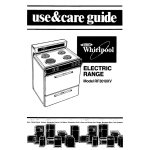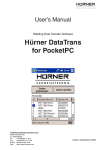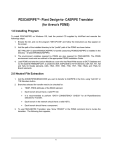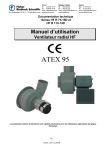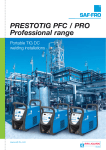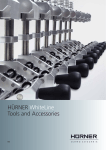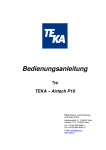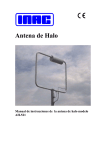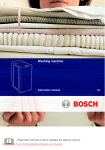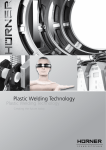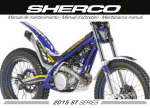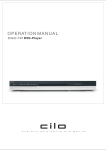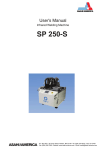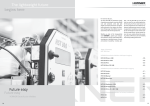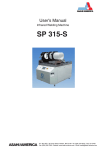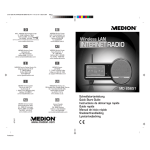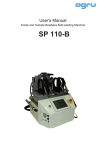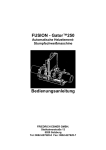Download CNC 2000 ECO-w
Transcript
User’s Manual Butt-welding Machine for Workshop Applications CNC 2000 ECO-w HÜRNER SCHWEISSTECHNIK GmbH Nieder-Ohmener Str. 2 D - 35325 Mücke Tel. +49 (0)6401 91 27 0 Fax +49 (0)6401 91 27 39 E-Mail [email protected] Web http://www.huerner-st.de Version April 2005 HÜRNER Schweisstechnik GmbH Nieder-Ohmener Str. 35325 Mücke, Germany Contents 1 2 2.1 2.2 2.5 2.4 2.5 2.6 2.7 3 3.1 3.1.1 3.1.2 3.1.3 3.2 3.3 3.3.1 3.3.2 3.3.3 3.3.4 3.3.5 4 4.1 4.2 5.10 4.4 4.4.1 4.4.2 4.4.3 4.4.4 4.4.5 4.4.6 4.4.7 4.4.8 4.4.9 4.4.10 4.5 5 5.1 6 Introduction .......................................................................................................... 5 Safety Instructions................................................................................................ 5 The User’s Manual ............................................................................................... 5 Explaining Icons ................................................................................................... 5 Safety Messages.................................................................................................. 5 Warranty ............................................................................................................... 6 Service and Repair............................................................................................... 7 Transport / Storage / Shipment ............................................................................ 7 Identifying the Machine ........................................................................................ 7 Understanding the Machine ................................................................................. 7 Machine Components .......................................................................................... 8 Component Overview........................................................................................... 8 Control Panel Components .................................................................................. 8 Emergency Stop Switch on the Control Panel ..................................................... 8 Technical Specs ................................................................................................... 9 Preparing to Weld Pipes and Fittings ................................................................... 9 Welding Elbows from Pipe Segments .................................................................. 9 Welding Ys with 60° Angle ................................................................................. 10 Welding Ys with 45° Angle ................................................................................. 11 Welding right-angles Tees .................................................................................. 12 Welding Crosses ................................................................................................ 13 Operation............................................................................................................ 13 Check-out, Turning the Machine On ................................................................... 13 Default Configuration of the Machine and the Set-up Menu .............................. 13 Entering Applicable Welding Parameters ........................................................... 15 Welding Process ................................................................................................ 15 Facing the Pipe Ends ......................................................................................... 16 Checking Pipe Alignment ................................................................................... 16 Changing Welding Parameters........................................................................... 16 Inserting and Monitoring the Heating Element ................................................... 16 Bead Build-up Phase ......................................................................................... 17 Heat Soaking Phase .......................................................................................... 17 Change-over Phase ........................................................................................... 17 Joining Phase..................................................................................................... 17 Cooling Phase .................................................................................................... 17 End of Welding ................................................................................................... 17 Welding Aborted................................................................................................. 18 Printing Welding Reports.................................................................................... 18 Printing, the Print Menu...................................................................................... 19 Service and Repair Contact ............................................................................... 19 Version April 2005 CNC 2000 ECO-w User’s Manual EN 3 HÜRNER Schweisstechnik GmbH Nieder-Ohmener Str. 35325 Mücke, Germany 4 EN CNC 2000 ECO-w User’s Manual Version April 2005 HÜRNER Schweisstechnik GmbH Nieder-Ohmener Str. 35325 Mücke, Germany 1 Introduction Dear Customer: Thank you very much for purchasing our product. We are confident that it will meet your expectations and hope that it will contribute to your professional success. The development, manufacture, and check of the heating element butt-welding machine has been guided by our concern to offer a device characterized by superior operation safety and user-friendliness. The device was manufactured and checked according to state-of-the-art technology and widely recognized safety regulations. To ensure maximum operation safety, please conform to the appropriate messages in this booklet and the regulations for the prevention of accidents. This manual is applicable to the following machines: CNC 2000 ECO-w Thank you. 2 Safety Instructions This User’s Manual contains important instructions for operating safely the heating element butt-welding machines Hürner CNC 2000 ECO-w. Every person who operates the machines will first have to read this Manual. 2.1 The User’s Manual The User’s Manual is presented according to sections, which explain the different functions of the machines. All rights, in particular the right to copy and distribute as well as to translate, are reserved. The copy or reproduction (in print or electronic form) is subject to the prior written authorization by HÜRNER Schweisstechnik, Mücke, Germany. 2.2 Explaining Icons The following expressions and icons are used in this User’s Manual to refer to safety-related issues: Caution This icon indicates that non-compliance may result in a hazardous situation that possibly causes bodily injury or material damage. This icon indicates important messages related to the correct use of the machine. Non-compliance may cause problems of operation Important and damage to the machine. This icon indicates tips and useful information for using the machine more efficiently and more economically. Info 2.5 Safety Messages Protect the power supply cord and the pressure lines from cutting edges. Have an authorized service shop replace damaged cables or lines immediately. • The device may be operated and serviced exclusively by authorized staff who have been trained on it. Version April 2005 CNC 2000 ECO-w User’s Manual EN 5 HÜRNER Schweisstechnik GmbH Nieder-Ohmener Str. 35325 Mücke, Germany • • The machine may be operated only when observed. Before operating the machine, always check for damaged parts and have them repair or replace by an authorized service shop as needed. The protective caps on the interface and the pressure lines have to be in place during transport so as to prevent contaminants and humidity from entering the machine. EVU wiring regulations, VDE provisions, DIN / CE regulations, and national laws will have to be respected. Without prior authorization by the manufacturer, no modifications may be made to the device. • • • Parts Under Power After opening the machine or removing the cover, parts of it are accessible that may be under power. The device may be opened Caution exclusively by an authorized service shop. Pipe Facing Tool Start the pipe facing tool only when it is in its working position; protect the facing surfaces from dirt and damage. Caution It is forbidden to remove shaving from the machine while the facing process is still running. Make sure nobody is present in this danger zone. Heating Plate When working with the machine, be extremely cautious while the heating plate is used. Since the heating plate presents a temperaCaution ture of more than 200°C during the welding process, it is absolutely necessary that operators wear suitable protective gloves. Please note that the heating plate will remain hot for a while after it was turned off. Danger of Bruises and Injury Do not remain in the danger zone while the machine opens or closes and be sure not to have you arms or hands between the moving and Caution the fixed trolley of the machine. Acceptable Work Conditions The work zone has to be clean and has to have proper lighting. It is dangerous to operate in a humid environment or close to inflamCaution mable liquids. In regard of this, acceptable work conditions have to be ensured (e.g., sufficient distance between the machine and other functional areas of the workshop). Info 2.4 User’s Manual The User’s Manual has to be available at any time on the site where the machine is used. If the User’s Manual should come to be incomplete or illegible replace it without delay. Feel free to contact us for assistance. Warranty Warranty claims may be raised only if the conditions for warranty given in the General Terms and Conditions of Sale and Shipment obtain. Furthermore, the conditions contained in the User’s Manual have to obtain. 6 EN CNC 2000 ECO-w User’s Manual Version April 2005 HÜRNER Schweisstechnik GmbH Nieder-Ohmener Str. 35325 Mücke, Germany 2.5 Service and Repair As the machine is used in applications that are sensitive to safety considerations, it may be serviced and repaired only on our premises or by subcontractors and partners who have been specifically trained and authorized by us. Thus, constantly high standards of operation quality and safety are maintained. Info 2.6 Non-compliance with this provision will dispense the manufacturer from any warranty and liability claims for the machine and any consequential damage. Transport / Storage / Shipment The machine is shipped on a palette. When loading or unloading the machine, ensure it is not tipped excessively. During transport, the pipe facing tool and the heating element have to be in the working position and to be secured properly in order to prevent them from tilting up. Stumpfschweißmaschine 2.7 Identifying the Machine Each machine is identified by a name plate. It shows the machine model (“Typ”), the serial number (“Maschinennr.”), and the manufacturer. The first two digits of the serial number represent the year of manufacture. 3 Typ CNC 2000 ECO-w Maschinennr. 05441019 Hürner Schweisstechnik Nieder-Ohmener Str. D - 35325 Mücke CE Tel. +49 6401 9127 0 Understanding the Machine The machine is a butt-welding machine for plastics, which has basically three functions: • Controlling the welding process; • Monitoring all the relevant parameters during the welding process; • Generating a report summarizing the welding process. The machine can be used both as on-site and as in-shop installation. Upon entering the type of plastic, the pipe diameter, and the wall thickness, the machine calculates all the parameters that are critical for the welding process, taking into account the applicable national welding standards (DVS, INSTA). The entire welding process is automatically controlled, monitored, and saved to a report. The saved welding data can subsequently be transferred directly to a printer or to a PC with DataWork / DataWork GIS installed. The pipe and traceability data needed can be entered using both the film-protected alphanumeric keypad and a barcode scanning wand. For various applications, the machine can be specifically configured in the Configuration Menu (see section 4.2 “Configuring the Machine”). The welder performs the welding process in the following manner: • Pipes are clamped into the frame; if welding elbows, Tees or Ys only after cutting the pipes for construction. • Pipe ends are worked using the pipe facing tool. • Pipe alignment is checked following the information on the display. • The heating element is inserted after cleaning it and checking the temperature. • After the heating element was inserted, the pipes close in automatically at the predefined build-up pressure. • During the build-up phase the weld bead builds up. • The machine then moves on automatically to the heat-soaking phase. • After the heat-soaking phase, the machine automatically moves the trolleys apart and the welder can remove the heating element. Version April 2005 CNC 2000 ECO-w User’s Manual EN 7 HÜRNER Schweisstechnik GmbH Nieder-Ohmener Str. 35325 Mücke, Germany • • • • 3.1 After the heating element was removed, the machine automatically joins the pipes together. This is followed by a steady pressure increase until the fusion pressure is reached. The pipe then cools down at the predefined pressure. After the cooling time is over, pressure is automatically removed from the pipe and the pipe can be taken out of the frame. Machine Components 3.1.1 Component Overview Pipe clamps (standard clamps shown) Heating Element Facing Tool Facing Tool Motor Scanning Wand Control Panel Machine Base Operation Lamp Hydraulics 3.1.2 Control Panel Components Display Keypad Emergency Stop On/Off Switch Welding Process Diagram MENU / Arrow Keys ENTER Key Interface (for printer / PC connection) ESC Key OPEN Key REDUCE PRESSURE Key INCREASE PRESSURE Key 3.1.3 Emergency Stop Switch on the Control Panel An Emergency Stop push button is provided on the control panel for interrupting the welding process, if needed, to prevent hazardous situations. If the 8 EN CNC 2000 ECO-w User’s Manual Version April 2005 HÜRNER Schweisstechnik GmbH Nieder-Ohmener Str. 35325 Mücke, Germany Emergency Stop button is pressed, it disables the power supply to the facing tool, the heating element, and the hydraulics. Power is further supplied to the micro-controller board (the display screen keeps working). When it was pressed, the Emergency Stop push button remains locked. When the hazard is cleared, the button has to be unlocked Important by turning it clockwise. It is also possible to move the trolley on the frame manually. 3.2 Technical Specs Hürner CNC 2000 ECO-w Power Characteristics Voltage Frequency Total Rated Power Heating Element Facing Tool Hydraulics 230 V 50 Hz 5.5 kW, 30 A 3.7 kW 1.5 kW 0.74 kW Protection Heating Element Facing Tool Hydraulics IP54 IP44 IP44 Operating Range 90 - 315 mm Hydraulic Characteristics Operating Pressure max. Cylinder Ambient Temperature Hydraulic Oil 110 bar 6.47 m² –5°C bis +50°C HLP 32 Dimesions and Weight Total Machine Dimensions Weight Maximum Trolley Stroke 3.3 1220 x 900 x 1500 mm 250 kg 210 mm Preparing to Weld Pipes and Fittings Depending on the type of welding operation, the standard clamps mounted on the trolleys of the butt-welding machine may have to be replaced by Tee elements or Y elements. 3.3.1 Welding Elbows from Pipe Segments Using the standard pipe clamps, it is possible to weld elbows of up to 45° from segments of pipe. The standard clamps are secured to the support panel on the trolley of the machine using bolts G, D, and E (see Diagram 1). To weld an elbow from segments, loosen bolts G, D, and E and tip the clamp fronts toward each other around the pivoting point G. Bolts D and E will remain in the slots prepared for this operation. To place the clamps in the correct poA B C D E F G Fixation Bolts of the Support Panel Fixation Bolts of the Support Panel Support Panel Fixation Bolts of the Pipe Clamp Fixation Bolts of the Pipe Clamp Angle Scale Fixation Bolts of the Pipe Clamp (pivoting point) Diagram 1 Version April 2005 CNC 2000 ECO-w User’s Manual EN 9 HÜRNER Schweisstechnik GmbH Nieder-Ohmener Str. 35325 Mücke, Germany sition for the intended angle, use the angle scale F for orientation. To weld elbows up to 30° place D and E as shown in Diagram 2, to weld elbows larger than 30°, as shown in Diagram 3. Diagram 2 After the machine was prepared, welding proper proceeds as explained in section 4. Diagram 4 shows an elbow welded from several segments of pipe with several welding operations. 3.3.2 Welding Ys with a 60° Angle To weld Ys, replace the standard pipe clamps with the Y clamp elements. Remove bolts G, D, and E and take the standard clamps from the the machine Diagram 3 trolleys. This allows free access to the support panels (see Diagram 5). Welding a Y will require that two welds will be performed. Diagram 4 Start by welding the 60° angle in the Y. To do so, place Y element Z on the left-hand support panel and Y element W on the right-hand support panel. Make sure that for securing the Y clamp element to the trolley, holes A, F, and H of the base (see Diagram 10) of element Z align with holes 6, 8, and 13 of Diagram 5 the left-hand support panel. Holes A, F, and H of the base of element W have to align with holes 4, 8, and 13 of the right-hand support panel (see Diagram 6). After the machine was prepared, welding proper proceeds as explained in sec- Diagram 6 Diagram 7 10 EN CNC 2000 ECO-w User’s Manual Version April 2005 HÜRNER Schweisstechnik GmbH Nieder-Ohmener Str. 35325 Mücke, Germany tion 4. Diagram 7 shows a 60° angle in a Y that was welded as described above. The second weld that needs to be performed will connect the angle just welded to the straight pipe in the Y. This requires placing both Y clamp elements onto the left-hand support panel (see Digram 8). For securing them to the trolley, align holes C, D, and G of Y element Z with holes 1, 17, 3 of the support panel. Align holes C, D, and G of the base of Y element W with holes 10, 14, and 11 of the support panel. Then place the standard pipe clamp on the right-hand support panel, secure it to holes 5, 7, and 11, and tip its front toward the centerline as far as possible. Diagram 8 After the machine was prepared, welding proper proceeds as explained in section 4. Diagram 9 shows a Y with a 60° angle that was welded as described above. 3.3.3 Welding Ys with a 45° Angle To weld a Y with a 45° angle, the procedure is analogous to welding a 60°angled Y (see section 3.3.2): First, the 45° angle is welded, then the straight pipe is connected to this angle. Start by removing the standard pipe clamps from the support panel and mount the Y clamp elements. Here, too, make sure that the holes in the base of the Y elements (see Diagram 10) are aligned with the proper holes of the support panel (see Diagram 5) for securing the clamps to the trolleys. Diagram 9 The holes B, A, H, and I of the base of Y element Z have to be aligned with the holes 4, 5, 12, 15 of the left-hand support panel, and the holes B, A, H, and I of the base of Y element W have to be aligned with the holes 1, 2, 12, 10 of the right-hand support panel (see Diagram 11). Diagram 10 For the first welding operation for making a Y with a 45° angle, cut the pipes as shown in Diagram 12. Leave 10 mm more length than needed at the centerline, where the pipes face each other. This extra length will be removed by facing before the second welding. The second welding operation is also performed analogous to a Y with a 60° angle: place both Y clamp elements onto the left-hand support panel and place one standard clamp onto the right-hand support panel (see Diagram 13). Make sure that the holes E, B, and A of the base of Y element Z align with the holes 4, 2, and 7 of the left-hand support panel, and the holes A, B, and E of the Version April 2005 CNC 2000 ECO-w User’s Manual EN 11 HÜRNER Schweisstechnik GmbH Nieder-Ohmener Str. 35325 Mücke, Germany base of Y elements W align with the holes 9, 6, and 12 of the left-hand support panel. The standard pipe clamp for welding elbows has to be placed onto the right-hand support panel in such a way that the angle scale shows 45° (see Diagram 1). After the machine was prepared in both cases, the welding operations proper proceed as explained in section 4. Diagram 14 shows a Y with a 45° angle welded as described above, after the first and after the second welding operation. Diagram 11 Diagram 12 3.3.4 Welding right-angles Tees To weld Tees, replace the standard pipe clamps with the Tee elements. Remove bolts G, D, and E and take the standard clamps from the the machine trolleys. This allows free access to the support panels (see Diagram 5). Welding a Tee will require that two welds will be performed. Diagram 13 Start the operation by welding the 90° elbow. To do so, place the Tee element intended for the left-hand side on the lefthand support panel and make sure that for securing the Tee clamp element to the trolley, holes A, B, C, and D of the base of the Tee element (see Diagram 15) align with holes 4, 5, 12, and 15 of the left-hand support panel. Holes A, B, C, and D of the base of the Tee element intended for the right-hand side have to align with holes 1, 2, 10, and 12 of the right-hand support panel. After the machine was prepared, welding proper proceeds as explained in section 4. Diagram 17 shows a 90° elbow, first welding for a Tee, that was welded as described above. After the first welding operation, the 90° elbow is cut, placed into the Tee clamp element and connected to the straight pipe by using the same welding procedure. Diagram 18 shows a Tee welded as described above, after the second welding operation. Diagram 14 12 EN Diagram 15 CNC 2000 ECO-w User’s Manual Version April 2005 HÜRNER Schweisstechnik GmbH Nieder-Ohmener Str. 35325 Mücke, Germany 3.3.5 Welding Crosses In principle, the procedure for welding crosses is analogous to welding Tees (see section 3.3.4). However, three welding operations will be needed in this case. After the standard pipe clamps were replaced with the Tee clamp elements, Diagram 17 the first two steps of this kind of welding consist of welding two 90° elbows. Diagram 16 Then, both elbows will be cut along the outer angle to face each other and will be placed in this state into the Tee clamp elements. The third and last welding then forms a cross out of the two elbows. 4 Operation 4.1 Check-out, Turning the Machine On Diagram 18 Important Important Before the control unit is turned on, check the oil level of the hydraulics and fill up HLP 32 hydraulic oil as needed. The surfaces of the heating plate have to be free of grease and clean, or they have to be cleaned. Make sure all connectors are tight in their sockets and make sure that the machine is operated only if the conditions for safe and intended Important use are met (see also section 2). After connecting the power supply cable to the mains power supply, the machine is turned on using the On/Off switch. It is possible that the main switch located on the mounting box inside the right-hand leg of the machine has to be turned into the On position to have the machine under power. 4.2 Default Configuration of the Machine and the Set-up Menu Display 2 shows the report number number (before the slash) and the weld number (after the slash) that will be attributed to the next welding operation. The weld number, which identifies the incremented number of weld, e.g. of a given commission, shows only if this function has been enabled in the Configuration Menu. Info To bring the machine in the open or the closed position (trolley moved apart or closed in) when no welding procedure is running, use the OPEN and the INCREASE PRESSURE keys. xxxxxx HUERNER xxxxx x CNC 2000 ECO-W x x Version 1.05PD x xxxxxxxxxxxxxxxxxxxx Display 1 Next Welding Time : 10:32 Date : 08.03.05 Prot. No. :0014/0005 Display 2 Version April 2005 CNC 2000 ECO-w User’s Manual EN 13 HÜRNER Schweisstechnik GmbH Nieder-Ohmener Str. 35325 Mücke, Germany The Configuration Menu is accessible by pressing the MENU key when Display 2 shows on the screen. When the operator presses the MENU key, the screen asks to enter a selection code (see Display 3). This is an access code that authorizes the operator to select and change machine parameters in the appropriate configuration menus. The selection code can be entered using both the keypad and the scanning wand to read the operator code. Enter Select Code ++++++ Display 3 After entering an incorrect code three times, the machine returns CONFIGURATION SELECTION CODE: automatically to the ready-to-weld screen (Display 2). If the access 415311 code for selecting and changing values that was entered is correct, Important the Configuration Menu shows on the screen, as in Display 4. In the Configuration Menu use the UP and DOWN arrow keys to select a specific configuration option. The option can then be set to On or Off using the RIGHT arrow key. The –M– displayed for the Set Clock, Choose Language, and Guideline options indicates that a sub-menu can be accessed by pressing the MENU key. REPORTS >Commissions No. on Welder Code on Memory Contr. on When you press the ENTER key, the settings will be saved and applied. Press ESC to quit the configuration menu without saving any Important modifications. Display 4 The Configuration Menu contains the options listed in the table below. Description Setting Data to be entered Commission Number ON / OFF To be entered before every welding, 32 alphanumeric characters Welder ID Code ON / OFF To be entered before every welding, ISO welder identification code Memory Control ON / OFF if ON: Machine stops when the memory is full if OFF: Machine overwrites the oldest report when the memory is full Weld Number ON / OFF To be entered before the first welding, machine increments by 1 for each subsequent weld Additional Data ON / OFF To be entered before every welding, 20 alphanumeric characters Monitor Ambient Temperature ON / OFF if ON: Ambient temperature will be checked when machine is turned on if OFF: No check of ambient temperature If the ambient temperature is below 0°C, no welding process should be started, or suitable steps should be taken. Manual Input ON / OFF if ON: It is possible to change the welding parameters manually; if OFF: manual change of welding parameters impossible Automode ON / OFF if ON: Build-up time included in the control software is used, the build-up phase will be ended automatically; if OFF: the build-up phase has to be ended manually by pressing the ENTER key Guideline —M— Selecting the welding standard (sub-menu) Set Clock —M— Setting the time of day and date (sub-menu) Choose Language —M— Setting the display/printer language (sub-menu) 14 EN CNC 2000 ECO-w User’s Manual Version April 2005 HÜRNER Schweisstechnik GmbH Nieder-Ohmener Str. 35325 Mücke, Germany 5.10 Entering Applicable Welding Parameters After having entered – if enabled – the traceability data, such as Commission Number, Welder ID Code, etc., you can start entering the welding data proper, or you can use the parameters from the preceding weld. After it was turned on, the machine goes on from Display 2 to Display 5 when you press the ENTER key. To keep the all displayed welding parameters for the following welding, press the ENTER key, the welding will start immediately. If data have to be changed for the next welding, press ESC. The first step consists of selecting the appropriate pipe material using the UP/DOWN cursor keys (see Display 6). Use the ENTER key to confirm you selection of the pipe material. The machine goes on automatically to the next menu item, entering the pipe dimesions. This screen (see Display 7) asks the welder to enter the diameter, the wall thickness or the standard dimension ratio (SDR) of the pipe that is going to be welded. This is done moving the cursor character by character and into the next line using the RIGHT arrow key. To be able to enter the SDR, first press the DOWN arrow key when they cursor is in the Wall thickness line. To apply the values entered, press the ENTER key. Finally, the type of welding is also part of the welding parameters (see Display 9). Here, too, use the UP and DOWN arrow keys to select the kind of welding that is going to be performed, and confirm your selection by pressing the ENTER key. The available options are Straight welding, Elbow welding, T Element, Y 45° Element, Y 60° Element, and Cross. If a Y element welding is selected in this menu, the welder has to specify furthermore if the welding is the first or the second for making this Y (see Display 10). If a elbow welded from pipe segments is selected, the angle the elbow is going to have has to be entered (see Display 11). When entering the angle to be welded, enter the full angle in degrees that the elbow should have; do not enter half the angle value. The standard pipe clamps of the machine, too, have to be aligned with Important the full angle value on the scale on the support panels rather than with half the intended value. Pipe material: PE80 Pipe diameter:0250mm Wallthickness:22.7mm Straight welding Display 5 SELECT PIPE MATERIAL >PE80 PE100 PP Display 6 ENTER PIPE DIMENSION Pipe diameter:0250mm Wallthickness:22.7mm Display 7 ENTER PIPE DIMENSION Pipe diameter:0250mm SDR : 9.0 Display 8 SELECT WELDING TYPE >Straight Welding Elbow Welding T Element Display 9 Y 45° ELEMENT >1. Welding 2. Welding Display 10 ENTER ANGLE Angle See section 3.3 for a detailed overview on how to prepare the machine for welding elbows, Tees, Ys and crosses. : 30 ° Display 11 Info Using the entered parameters on pipe material, pipe dimension, and type of welding, the machine calculates the required pressures, welding phase duration, and the temperature of the heating element. After you have entered the parameters, they are displayed once again for verification. The data shown can still be changed by pressing the UP arrow key to go back one step at a time and access the screen in question. Confirm these values by pressing ENTER in order to go on to the welding process proper. 4.4 Welding Process Before you start welding, the machine has to be prepared for the intended type of welding. If necessary, the standard pipe clamps have to be adjusted to the correct angle scale on the support panels, or they have to be replaced with the Tee element or Y elements. See section 3.3 to learn how the special elements are placed onto the support panels and adjusted. Version April 2005 CNC 2000 ECO-w User’s Manual EN 15 HÜRNER Schweisstechnik GmbH Nieder-Ohmener Str. 35325 Mücke, Germany After the machine was prepared, the welding parameters for the following weld were entered (see section 4.3) and confirmed by pressing the ENTER key, the machine starts the welding process by facing the pipe ends (see Display 12). 4.4.1 Facing the Pipe Ends To ensure the pipe ends are level, insert the pipe facing tool into the machine. Clicking its handle into place in its working position turns it on automatically. The machine will then bring the pipes to the facing tool at the predefined pressure. Use the INCREASE PRESSURE and REDUCE PRESSURE keys to adjust the pressure during facing manually. Facing pipe ends Display 12 Pipe facing should continue until shaving forms a continuous blade that rolls twice or three times around the pipe ends, so the butts are level. Facing is stopped by pressing the ENTER key. The machine automatically retracts the pipes. If you discover after the facing process that the butts are still not level, start over, open the machine completely, insert the facing tool, thereby launching pipe facing automatically. When facing is properly done, pipe alignment has to be checked. 4.4.2 Checking Pipe Alignment Press the ENTER key to have the machine place the pipes together automatically. On the screen (Display 13), the maximum acceptable alignment gap between the pipes is shown. If the pipes align properly, this has to be confirmed by pressing the ENTER key. Check pipe alignment Max. gap : 2.5mm Display 13 If the gap is too large, re-adjust the pipes in the clamps and start the facing process again as needed. To do so, place the machine in the open position first using the OPEN key. Then insert the facing tool, launching the facing process by clicking the handle into place in its working position. You can abort the welding process by pressing ESC. 4.4.3 Changing Welding Parameters IWhen pipe alignment was checked, the machine moves on automatically to Display 14 if the Manual Input option is enabled in the Configuration Menu. In Display 14, the welder can keep the welding parameters from the last weld by pressing the ENTER key or he can adjust them to his specific purposes by pressing the ESC key (see Display 15). Do you want to use data of previous welding? ESC <¬ Display 14 If the parameters for the next welding process are entered manually, the UP and DOWN arrow keys are used to select the line the is to be changed, and the new value is typed on the keypad. The parameters are saved and applied by pressing the ENTER key; the machine moves on from Display 15 to Display 16 or from Display 16 back to the welding process. Heating pr.:030.5bar Heatsoakpr.:010.5bar Heat soak :0120 s Change-over:0005 s The parameters set manually are kept in memory when the machine is turned off. Only the pressure values are calculated individually for each welding process. If the pipe dimensions change, all parameters Important have to be set once again. The machine recognizes the change of dimension and leads the operator directly to the menu that allows changing the parameters. Cool. time :0900 s Pr. build-up:0010 s Heat. temp. :0223 °C 4.4.4 Inserting and Monitoring the Heating Element The machine controls and monitors constantly the temperature of the heating element. If the temperature is not within the tolerance thresholds, the machine shows an error message to this effect in the first line of the display. Furthermore, the upper and lower thresholds of the tolerance range are indicated in the fourth line along with the current actual temperature (see Display 17). Display 15 Display 16 Plate temp. too low 222°C< 210 °C <232°C Display 17 16 EN CNC 2000 ECO-w User’s Manual Version April 2005 HÜRNER Schweisstechnik GmbH Nieder-Ohmener Str. 35325 Mücke, Germany As soon as the nominal temperature is reached, Display 18 shows. Put in heat. plate By inserting the heating element, you make the machine move on to the Buildup Phase. At this time, the pipes are placed together automatically and the calculated pressure during bead build-up is applied. 222°C 221°C 4.4.5 Bead Build-up Phase IDuring the Build-up Phase LED 1 flashes to indicate the progress of the welding process. As soon as the build-up pressure is achieved, as shown in Display 19, the display indicates both the maximum bead height and the time so far used for build-up. During this phase, the build-up pressure and the heating element temperature are constantly monitored. When the bead height indicated on the display is reached, the operator has to press the ENTER key to terminate the Build-up Phase. The machine then continues automatically to the Heat Soaking Phase. NOM. ACT. 16.5bar 0.5bar Display 18 Bead height :2.0mm Bead buildtime:68 s 230°C NOM. 16.5bar 229°C ACT. 2.5bar Display 19 As long as the nominal pressure of the Heat Soaking Phase is not reached yet, LED 2 flashes while LED 1 is steadily lit. The machine reduces pressure automatically. If the Automode option is enabled in the Configuration Menu, the Build-up Phase will be terminated automatically at the end of the bead build-up time included in the control software. If this is not the Important case, the end of the Build-up Phase has to confirmed manually. 4.4.6 Heat Soaking Phase The time for soaking heat is displayed as a countdown showing the remaining seconds (see Display 20). A signal is audible during the final 10 seconds of heat soak immediately before the change-over. During the Heat Soaking Phase LED 3 flashes; LED 1 and LED 2 are steadily lit. During this phase, the pressure applied while the pipes soak the heat from the plate and the plate temperature are constantly monitored and controlled. 4.4.7 Change-over Phase After the full heat soaking time, the pipes retract automatically. The heating element has to be removed as fast as possible (see Display 21). During the Change-over Phase LED 4 flashes; all previous LEDs are steadily lit. The machine then places the pipes automatically together again. 4.4.8 Joining Phase In the Joining Phase the machine increases pressure in accordance with the pressure ramp calculated for the weld (see Display 22). During this phase LED 5 flashes; all previous LEDs are steadily lit. 4.4.9 Cooling Phase When the full joining pressure is reached, the machine moves on automatically to the Cooling Phase (see Display 23). The cooling-down is displayed as a countdown. During cooling, the joining pressure applied is constantly monitored. During this phase, LED 6 flashes, all the previous LEDs are steadily lit 4.4.10 End of Welding A double buzz indicates that the cooling time has ended. Furthermore, the green LED is steadily lit to indicate a successful welding process. Confirm the HEAT SOAK PHASE Heatsoak time:168 s 230°C NOM. 16.2bar 229°C ACT. 3.2bar Display 20 Remove plate Change-over : 8 s 230°C NOM. 16.5bar 229°C ACT. 3.5bar Display 21 JOINING PHASE 230°C 229°C NOM. ACT. 16.5bar 3.5bar Display 22 COOLING PHASE Cooling time over 229°C ACT. 0.0bar Display 23 Version April 2005 CNC 2000 ECO-w User’s Manual EN 17 HÜRNER Schweisstechnik GmbH Nieder-Ohmener Str. 35325 Mücke, Germany end of welding be pressing the ENTER key. Pressure will then be switched off from the machine. 4.5 Welding Aborted All welding-relevant data are constantly monitored while the welding process is running. If one or more of the parameters are out of tolerance and cannot be controlled to adjust, the welding process is aborted after a given period of time. WELDING STOPPED Error Build-up pres. 229°C ACT. 1.5bar Display 24 In these cases the error that made the welding process abort is displayed (see Display 25). In addition, the corresponding LED flashes. The error message has to be confirmed by pressing the ENTER key. The errors listed in the following table are recognized and displayed on the screen. Type of Error Description a. Data Input Input Error Erroneous parameter input b. System Clock Defective Internal clock of the machine is defective; use the Cnfiguration Menu to reset the clock Pressure Sensor defective Pressure sensor defective Heating Sensor defective Heating element not connected, check connector/socket Temperature Sensor defective Ambient temperature sensor is defective c. Welding Process Temperature low Heating element temperature will be increased automatically Temperature high Heating element temperature will be reduced automatically Error Changeover It took too long to retract the mirror and bring the pipes to joining; welding will have to be repeated Ambient Temperature high Ambient temperature outside the range from 0°C to 50°C Ambient Temperature low Ambient temperature outside the range from 0°C to 50°C Error Drag Pressure Impossible to determine the drag pressure; maybe pipes will have to be clamped once again Error Build-up Pressure Calculated maximum pressure too high; impossible to start welding; maybe pipes will have to be clamped once again Error Heat Soak Pressure Heat soaking pressure too high; impossible to re-adjust Error Joining Pressure Joining pressure too high or too low; impossible to re-adjust Cooling Stopped Operator has stopped the cooling time by pressing the ESC key Power Supply Failure In the course of the last welding a power supply failure occurred; welding has to be repeated Error Plate Temperature Plate temperature is out of tolerance; impossible to re-adjust the temperature; maybe the ambient temperature was too low 5 Printing Welding Reports The machine is equipped with a dual interface that gives you the opportunity to connect a common PC printer directly to it or to export the data via a RS232 cable to a PC with DataWork or DataWork GIS installed. 18 EN CNC 2000 ECO-w User’s Manual Version April 2005 HÜRNER Schweisstechnik GmbH Nieder-Ohmener Str. 35325 Mücke, Germany Technical Specs of the Interface: • Parallel + Centronics • Serial + RS232 Baud Rate Data Bits Stop Bits Transfer Protocol 5.1 19200 Baud 8 2 X_ON / X_OFF Printing, the Print Menu When a data communication cable (Centronics, Serial) is connected, the machine displays the Print Menu. Data will be sent according to the selection to the a printer or to a PC. Use the UP/DOWN arrow keys to switch between Print all Protocols and Print Commission No. and press ENTER to confirm your selection of a print mode. The Print all Protocols mode causes all the report protocols stored in system memory to be printed off. The Print Commission No. mode leads the operator automatically to the next screen where the commission number to be printed is selected (see Display 26). If the Print Commission No. mode is selected in the Print Menu, the first available commission number is displayed. Use the UP/DOWN arrow keys to display one after the other the commission numbers stored in system memory. Select one of them and press ENTER to send the data from this commission only to the printer or PC. If the machine displays a “Printer not Ready” error message after you pressed ENTER, the printer has to be switched to on-line mode. Check for potentially damaged connections from the machine to the printer or the PC. xxx PRINT MENU xxx >Print all protocols Print commission no Display 25 Print commission no ++++++++++++++++++++ ++++++++++++ Display 26 If you transfer the data to a PC, make sure to select the correct baud rate and interface type. Info 6 Depending on the printer used, make sure Auto Carriage Return and/or Auto Line Feed are enabled, if necessary, so as to print the reporting protocol in the correct format. Service and Repair Contact Hürner Schweisstechnik Nieder-Ohmener Str. 35325 Mücke, Germany Tel.: +49 (0)6401 9127 0 Fax: +49 (0)6401 9127 39 Web: www.huerner-st.de Mail: [email protected] Version April 2005 CNC 2000 ECO-w User’s Manual EN 19 KONFORMITÄTSERKLÄRUNG Declaration of Conformity Déclaration de conformité Wir / We / Nous HÜRNER Schweißtechnik Nieder-Ohmener Str. D-35325 Mücke-Atzenhain erklären in alleiniger Verantwortung, dass das Produkt declare under our sole responsibility that the product déclarons sous notre seule responsabilité que le produit CNC 2000 ECO-w Heizelement-Stumpfschweißmaschine für die Verarbeitung von Kunststoffrohren und -formteilen Heating element butt-welding machine for processing plastic pipes and fittings Machine à souder bout-à-bout à élément chauffant pour l’assemblage des tubes et raccords en plastique, auf die sich diese Erklärung bezieht, mit den folgenden Normen oder normativen Dokumenten übereinstimmen to which this declaration relates, are in conformity with the following standards or standardizing documents auxquels se réfère cette déclaration, sont conformes aux normes et documents de normalisation suivants CE-Konformität / CE Conformity / Conformité CE EG Richtlinie 89/336 EWG EG Niederspannungsrichtlinie 73/23 EWG Andere Normen / Other Standards / Autres normes EN 50081-1 Generic Emission Standard 03.93 EN 50082-1 Generic Immunity Standard 03.93 EN 60335-1 / IEC 335-1 1995 Bei einer nicht mit uns abgestimmten Änderung der Maschine oder einer Reparatur von Personen, die nicht von uns im Hause geschult und autorisiert wurden, verliert diese Erklärung ihre Gültigkeit. Any and all modifications of the device without our prior approval, and any repairs by persons who were not trained and authorized by us, shall cause this declaration to become void. En cas de modification apportée à l’appareil sans notre accord préable ainsi que de réparation effectuée par des personnes non formées et agréées par non soins, cette déclaration deviendra caduque. Mücke-Atzenhain den 01.04.2005 (Ort und Datum) (Place and date) (Lieu et date) ................................................................ (Hans Strasser) Name und Unterschrift des Befugten / Leitung Fertigung Name and signature of the authorized / Head of Manufacture Nom et signature du responsable / Direction de Fabrication ................................................................. (Dipl.Ing. Michael Lenz) Name und Unterschrift des Befugten / Leitung Entwicklung Name and signature of the authorized / Head of Development Nom et signature du responsable / Direction de Développement






















